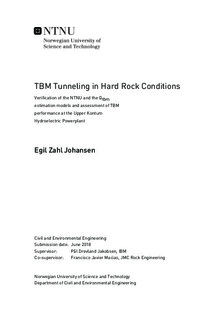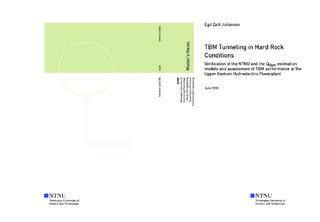| dc.description.abstract | The use of Tunnel Boring Machines when excavating tunnels allows for a highly industrialized form of production, while at the same time introducing new kinds of risks and challenges in regards of performance estimation and advance rates. The work in this thesis is focused on verifying the NTNU-and $Q_{TBM}$-models for performance estimation. In addition, there has been conducted an assessment of the time required for achieving high utilization after a longer period of stand-still due to maloperation of a TBM. A general assessment of the project execution is included to set the performance in context with its surroundings.
A field study at the Upper Kontum Hydroelectric Powerplant in Vietnam was conducted to gather data and to do a general assessment of the work at the site. Geological back-mapping of parts of the tunnel and penetration tests with the TBM was conducted, in addition to assessing the general quality of the production system. Geology and performance data for the entire tunnel length was reviewed in cooperation with the project geologists to ensure a correct assessment and analysis.
The data gathered suggested that both estimation models gave quite accurate results for net penetration rate in the geology found at site, while also suggesting that the $Q_{TBM}$-model in certain cases is too influenced by the applied cutter thrust. There should be expected approximately six months of reduced utilization before an increase is observed when restarting a project, due to the complexity of ensuring all systems work properly after maloperation of the TBM. The utilization given by the NTNU-model appears to be somewhat optimistic, while utilization given by the $Q_{TBM}$-model does not provide a realistic estimation. The use of wider cutter tips appears to ensure a significantly higher expected lifetime than what is suggested by the Cutter Lifetime Index.
In total, TBM performance can be accurately estimated when using the estimation models. There should however be extensive knowledge regarding the functional structure of the models, to ensure that their limitations are well understood. Replacing contractors and taking over machines should be done with extensive care, as the potential limitations on utilization may cause severe delays and cost overruns. | |

